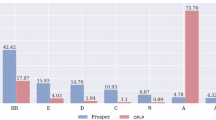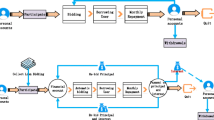Abstract
Online peer-to-peer (P2P) lending financial products have been developing rapidly in recent years. This investment method is designed for people free of high-rate debts. However, the lending and borrowing affairs between anonymities may potentially produce risks, including wash sale and money laundering. Apart from the well-documented research on the causal factors and economic influence of the P2P lending market, limited attention has been paid to the risk management of individual P2P lending platforms. This study presents a visual analysis method that detects and analyzes risks in P2P lending transactions. Moreover, we evaluate our approach on real-world P2P data sets and report our findings.















Similar content being viewed by others
References
Archambault D, Purchase HC (2016) Can animation support the visualisation of dynamic graphs? Inf Sci 330:495–509
Berger SC, Gleisner F (2009) Emergence of financial intermediaries in electronic markets: the case of online P2P lending. BuR-Bus Res 2(1):39–65
Bachmann A, Becker A, Buerckner D, Hilker M, Kock M, Lehmann M, Tiburtius P (2011) Online peer-to-peer lending—a literature review. J Int Bank Commer 16(2):1–18
CBN News Finance Research Center (2013) China P2P lending service white paper. China Economic Publishing House, Beijing
Ceyhan, S., Shi, X., & Leskovec, J. (2011) Dynamics of bidding in a P2P lending service: effects of herding and predicting loan success. In Proceedings of the 20th international conference on World Wide Web (pp. 547–556). ACM
Chen X, Ding XY, Wang BF (2013) A study of the overdue behaviors in private borrowing—empirical analysis based on P2P network borrowing and lending. In Finance Forum 11:010
Choustova O (2009) Quantum probability and financial market. Inf Sci 179(5):478–484
Freedman, S., & Jin, G. Z. (2008) Do social networks solve information problems for peer-to-peer lending? Evidence from prosper.com
Freedman S, Jin GZ (2017) The information value of online social networks: lessons from peer-to-peer lending. Int J Ind Organ 51:185–222
Fruchterman TM, Reingold EM (1991) Graph drawing by force-directed placement. Software: Pract Exp 21(11):1129–1164
Ge R, Feng J, Gu B, Zhang P (2017) Predicting and deterring default with social media information in peer-to-peer lending. J Manag Inf Syst 34(2):401–424
Goldberg J, Helfman J (2011) Eye tracking for visualization evaluation: reading values on linear versus radial graphs. Inf Vis 10(3):182–195
Gonzalez L, Loureiro YK (2014) When can a photo increase credit? The impact of lender and borrower profiles on online peer-to-peer loans. J Behav Exp Financ 2:44–58
Greiner ME, Wang H (2010) Building consumer-to-consumer trust in e-finance marketplaces: an empirical analysis. Int J Electron Commer 15(2):105–136
Herzenstein M, Dholakia UM, Andrews RL (2011) Strategic herding behavior in peer-to-peer loan auctions. J Interact Mark 25(1):27–36
Herzenstein M, Sonenshein S, Dholakia UM (2011) Tell me a good story and I may lend you money: the role of narratives in peer-to-peer lending decisions. J Mark Res 48(SPL):S138–S149
Hildebrand T, Puri M, Rocholl J (2016) Adverse incentives in crowdfunding. Manag Sci 63(3):587–608
Ilango MR, Mohan V (2010) A survey of grid based clustering algorithms. Int J Eng Sci Technol 2(8):3441–3446
Iyer R, Khwaja AI, Luttmer EF, Shue K (2015) Screening peers softly: inferring the quality of small borrowers. Manag Sci 62(6):1554–1577
Kamada T, Kawai S (1989) An algorithm for drawing general undirected graphs. Inf Process Lett 31(1):7–15
Kimura M, Saito K (2006) Tractable models for information diffusion in social networks. In European Conference on Principles of Data Mining and Knowledge Discovery. Springer, Berlin, Heidelberg, pp 259–271
Kou G, Peng Y, Wang G (2014) Evaluation of clustering algorithms for financial risk analysis using MCDM methods. Inf Sci 275:1–12
Lin M, Prabhala NR, Viswanathan S (2013) Judging borrowers by the company they keep: friendship networks and information asymmetry in online peer-to-peer lending. Manag Sci 59(1):17–35
Liu Y, Wang C, Ye P, Zhang K (2015) Analysis of micro-blog diffusion using a dynamic fluid model. J Vis 18(2):201–219
Matsubara, S. (2001) Accelerating information revelation in ascending-bid auctions: avoiding last minute bidding. In Proceedings of the 3rd ACM Conference on Electronic Commerce (pp. 29–37). ACM
McNamara GR, Zanetti G (1988) Use of the Boltzmann equation to simulate lattice-gas automata. Phys Rev Lett 61(20):2332–2335
P2P Lending Industry Data (2018) WDZJ website. Retrieved May 4, 2018, from https://shuju.wdzj.com/industry-list.html
Pope DG, Sydnor JR (2011) What’s in a picture? Evidence of discrimination from Prosper.com. J Hum Resour 46(1):53–92
Quinn NR, Breuer MA (1979) A force directed component placement procedure for printed circuit boards. IEEE Trans Circuits Syst CAS-26(6):377–388
Puro L, Teich JE, Wallenius H, Wallenius J (2010) Borrower decision aid for people-to-people lending. Decis Support Syst 49(1):52–60
Romero, D. M., Meeder, B., & Kleinberg, J. (2011) Differences in the mechanics of information diffusion across topics: idioms, political hashtags, and complex contagion on twitter. In Proceedings of the 20th international conference on World Wide Web (pp. 695–704). ACM
Saito K, Kimura M, Ohara K, Motoda H (2010) Behavioral analyses of information diffusion models by observed data of social network. In International Conference on Social Computing, Behavioral Modeling, and Prediction. Springer, Berlin, Heidelberg, pp 149–158
Tengvall, Marcus, and Gustav Claesson. (2015) Peer-to-peer lending: the effects of institutional involvement social lending. (Master’s thesis, Jönköping International Business School, Jönköping University). Retrieved from https://pdfs.semanticscholar.org/4403/d14fc618de64b5f7486f8bd73996057c8922.pdf
Van der Lans R, Pieters R, Wedel M (2008) Eye-movement analysis of search effectiveness. J Am Stat Assoc 103(482):452–461
Wei Z, Lin M (2016) Market mechanisms in online peer-to-peer lending. Manag Sci 63(12):4236–4257
Yum H, Lee B, Chae M (2012) From the wisdom of crowds to my own judgment in microfinance through online peer-to-peer lending platforms. Electron Commer Res Appl 11(5):469–483
Zemla A (2003) LGA: a method for finding 3D similarities in protein structures. Nucleic Acids Res 31(13):3370–3374
Zhang J, Liu P (2012) Rational herding in microloan markets. Manag Sci 58(5):892–912
Acknowledgments
We would like to thank Jie Xu, who assisted in analyzing data using MatLab. We also thank Yuhua Liu, who assisted us with the FF model.
Funding
The current study is partially supported by the National Nature Science Foundation of China (No. 61572348, 71201113, 71671120, and 71661137001) and National High Technology Research and Development Program (863) of China (No. 2015AA020506) and China Scholarship Council (No. 201406250112).
Author information
Authors and Affiliations
Corresponding author
Rights and permissions
About this article
Cite this article
Xiao, Z., Li, Y. & Zhang, K. Visual analysis of risks in peer-to-peer lending market. Pers Ubiquit Comput 22, 825–838 (2018). https://doi.org/10.1007/s00779-018-1165-y
Received:
Accepted:
Published:
Issue Date:
DOI: https://doi.org/10.1007/s00779-018-1165-y




